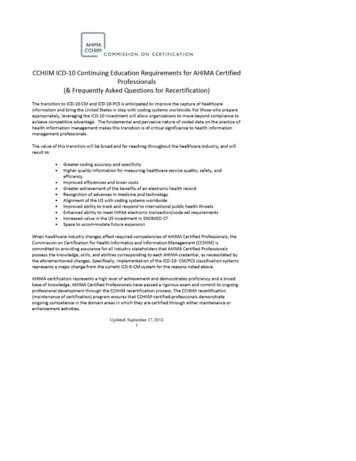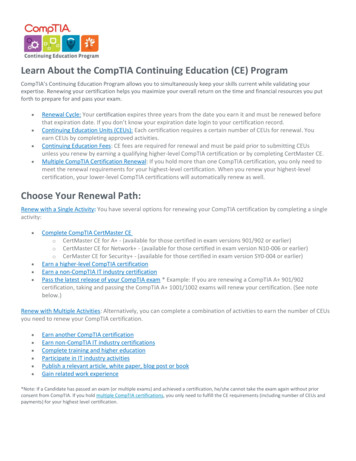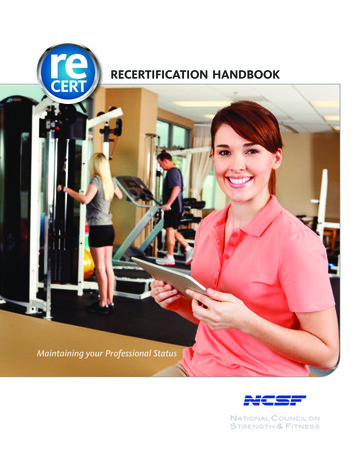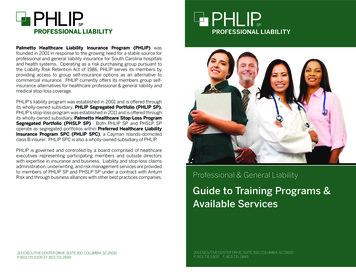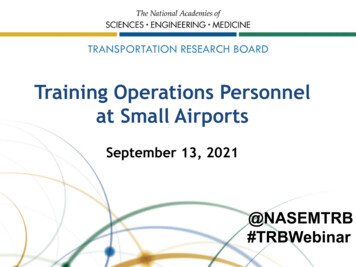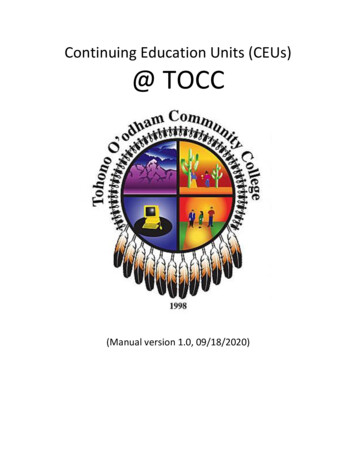
Transcription
Continuing Education Units (CEUs)@ TOCC(Manual version 1.0, 09/18/2020)
CEU ManualPurposeThe purpose of this guide is to provide standardized direction for the delivery of CEU courses atTOCC. The mission of TOCC states “ TOCC’s mission is to enhance our unique Tohono O’odhamHimdag by strengthening individuals, families, and communities through holistic, quality highereducation services. These services will include research opportunities and programs that addressacademic, life, and development skills.” While TOCC provides a wide range of academic andtrade related programs to address these areas, CEU course opportunities are a mechanism togo beyond the academic experience of the College and provide additional educationalexperience that can strengthen individuals, families, and our Tohono O’odham communities,through continued development of life skills, career skills, professional development, andcontinued improvement opportunities.The following provides a visual description of the CEU process.The CEU course process at TOCCAny employee of TOCC or community member of the Tohono O’odham Nation can propose aCEU course by contacting the Dean of Academics or Dean of Sustainability. Table 1 indicateswhat types of CEU each Dean oversees, but either can assist someone with the CEU process andwork with each other to assist anyone interested in providing CEU courses at TOCC.
Table 1. What Dean do I see if I have a CEU idea?Dean of SustainabilityDean of AcademicsCEU courses that focus on workforceCEU courses that provide continuedevelopment that results in:educational experience that is related toTOCC’s academic areas: Gaining employment Fine arts and digital media Increasing competency or skills withina given career field that results in Business and casino gamingpromotion or career change. Computer Information Systems Improves or enhances workplace Early Childhood Educationperformance and experience. Elementary EducationAny area within the following degree areas: Humanities Agriculture Life Science Building and Construction Trades Physical Science Culinary Arts Social Science Sustainability Industries Social Work Tohono O’odham Studies and*If area is not listed contact, any Dean canLanguageassistWhen meeting with the Dean they will explain the CEU process, explain the qualifications of theCEU Instructor, help determine if the college can support the CEU course, and provideinstructions and guidance on completing the CEU proposal.CEU Units and Contact hoursAt TOCC CEU credits are determined by the number of direct contact hours. Direct contacthours mean that the Instructor and course participants are actively engaging in the learningexperience. Therefore, CEU session breaks must be excluded from the calculation of CEU credithours. This becomes important for all day CEU sessions that include multiple breaks and lunchor dinner breaks. If there is no learning that occurs during the lunch or dinner time, this timemust not be included in the CEU hour calculation. If learning does occur during this time, itmust be clearly shown on the session outline and session materials. A CEU unit is calculated by15 contact hours equals 1 CEU.Qualifications of the CEU InstructorIn order to provide CEUs at TOCC the Instructor must have at least one educational degree levelabove the participants of the CEU courses or have significant and qualified professionalexperience in the area of Instruction which is determined by the Dean of Academics or Dean ofSustainability. Exceptions of educational experience can be made for areas of specializationswhere the Instructor can provide evidence of certification or training in area of specialization.
CEU course proposal (Attachment A)Title of the CourseProvide a short and concise title that indicates what the subject of the CEU course is about.Dates, times, location, and method of deliveryEven if the times dates and location have not been set, provide a proposal of what the schedulewould look like and how the course would be delivered. If the date, time, and location has beenset, note that in the proposal.Course descriptionThe course description orients students by outlining the rationale for the course subject ortheme, framing a brief overview of the key content, knowledge, and skills to be learned, andstating the major learning strategies and activities that students will experience.Format of a course description:WHY? Purpose or rationale for the course/subject area covered (1st sentence)WHAT? Key content/principles/topics to be learned (2nd sentence and/or 3rd sentence)HOW? Types of major learning activities and student experiences in the course (last sentence)(case study, mock interviews, role-playing, group discussions, etc.)Tips for writing a good course description: The course description should be no longer than 100 words. Write from a student-centered perspective. Use present tense and active voice. Use clear and simple sentence structure and language. Use gender neutral language. Use common terms that prospective students understand.Course goalsCourse goals are broad, general statements of what you want your students to learn. Usually aCEU course should have at least one to two learning goals for every 15 hours of contact. Coursegoals should have the following qualities:1. Course goals reflect what you want your students to know and understand.2. Course goals should be deliberately broad and vague.3. Goals should reflect essential questions for your course and/or discipline.Course outlineThe course outline should include a brief topical overview of the course and include proposedtiming. For example:
9:00am to 9:15am Welcome and Introduction9:15am to 9:45am Ice breaker and Participant Introduction9:45am to 10:00am Introduce topic 1And so onCourse outcomesLearning outcomes are measurable statements that concretely formally state what students areexpected to learn in a course. While goals or objectives can be written more broadly, learningoutcomes describe specifically how learners will achieve the goals. Rather than listing all of thedetailed categories of learning that is expected, learning outcomes focus on the overarchingtakeaways from the course. Generally, there are two to three course outcomes for each coursegoal.Assessment procedureCEU should include two types of assessments. The first assessment should determine whetheror not the course outcomes were achieved. The second assessment is to assess the quality andlearning experience of participants. The second assessment is achieved with a satisfactionsurvey. The first assessment can be conducted in several ways and should be taken intoconsideration in the design of the CEU course. The assessment process can include: Pre- and post- assessment Formal exam Post what did you learn survey Informal assessment of learning (used for skill development or competency based CEUcourses)Description of learning materialsProvide a list of learning materials that participants will receive.Instructor(s) BiographyProvide a short three to five sentence professional biography of each of the Instructors who willbe teaching the CEU course.Attachment: Instructor(s) Resume (which includes education)Attach all the Instructors resumes or curriculum vitas so that credentials of each instructor canbe evaluated.Documentation of CEU coursesAdvertisement materialAdvertisement and promotional material should include the following information: Course title as stated in the proposal Description of the course Who should attend the course? Date and Times of the course, including time commitment of participants.
TOCC official logo with statement “Continuing education opportunity provided throughTohono O’odham Community College, the Tohono O’odham Nation’s regionallyaccredited center for Higher Education.”Name of Instructor(s) with credentials.Request that Native American Tribal members bring a copy of their Tribal IDRegistration form (Attachment B)The registration form is provided in attachment B and is for record keeping purposes and isused for proper spelling and distribution of CEU certificates. Registration form also confirmsNative American status and request for proof of Indian Tribal identification.Sign-in and sign-out form (Attachment C)The sign-in and sign-out form is an important evidence document that proves participantswhere present for the claimed contact hours. It is important that this be completed withparticipant’s original signatures.Tracking sheetOnce the CEU course is approved the CEU Instructor will be provided with an excel spreadsheet.When the course is complete the tracking sheet must be completed and submitted with thedocumentation.Certificate of CEU (Attachment D)Once the CEU course has ended, data is submitted to the Dean’s office that approved the CEUcourse. It is the responsibility of that Dean’s office to review the documentation and completethe certificates and work with the Instructor to distribute the CEU certificates.Data Collection and ManagementOnce participants have been awarded to the participants the Dean’s office submits all thefollowing information to the Admissions and Records Office: CEU approved proposal Advertisement material Registration Forms Copy of Tribal ID or Tribal proof documentation Sign-in and sign-out sheet Tracking Excel file Copy of participant’s certificate
ATTACHMENT A: CEU ProposalName:Title:Date:Organization Affiliation:Phone Number:Email:Address:City:State:Zip Code:1. Title of the Course.2. Dates, times, location, and method of delivery (in-person, online, webinar,correspondence, etc.)?3. Course description (The course description orients students by outlining the rationale for thecourse subject or theme, framing a brief overview of the key content, knowledge and skills tobe learned and stating the major learning strategies and activities that students willexperience.)4. Course goals (Course goals are broad, general statements of what you want your students tolearn.)5. Course outline (The course outline should include a brief topical overview of the course andinclude proposed timing)6. Course outcomes (Learning outcomes are measurable statements that concretely formallystate what students are expected to learn in a course.)
7. Assessment procedure (CEU should include two types of assessments. The first assessmentshould determine whether or not the course outcomes were achieved. The second assessmentis to assess the quality and learning experience of participants)8. Description of learning materials (Provide a list of learning materials that participants willreceive.)10. Instructor(s) Biography (Provide a short three to five sentences professional biography ofall Instructors)Attachment: Instructor(s) Resume/Curriculum Vitae
ATTACHMENT B: Registration Form
Registration FormWelcome to [place CEU course Description here] and Tohono O’odham Community College.The purpose of this form is for documentation purpose only and for certificate creation. Yourinformation will not be used for promotional purpose and will not be sold or provided toexternal sources. All information is protected under the Family Educational Rights and PrivacyAct which prohibits an educational institution from releasing a student’s information to anyoutside entity, unless the institution is given written explicit permission by the student.Date:First Name:Last Name:Middle Name:Occupational Title:Organization Affiliation:Phone Number:Email:Address:City:State:Zip Code:Are you Native American? Yes NoIf you marked “Yes” what is your tribal affiliation?*Please provide a copy of your Tribal ID
ATTACHMENT C: Sign-in and Sign-out Sheet
Tohono O’odham Community College CEU Sign-in and Sign-out SheetName of Course:Print NameArrivalTimeSignatureEndTimeThe Lead Instructor affirms that the participants have demonstrated the knowledge andskills for this CEU course. Verification includes the validation of sign-in/out information,assessment of learning, and/or survey feedback.Lead Instructor’s Signature:SignatureDate:Instructor(s) Name:Page of
ATTACHMENT D: Sample Certificate
Continuing Education Units (CEUs) @ TOCC (Manual version 1.0, 09/18/2020) CEU Manual Purpose The purpose of this guide is to provide standardized direction for the delivery of CEU courses at . CEU Units and Contact hours At TOCC CEU credits are determined by the number of direct contact hours. Direct contact
